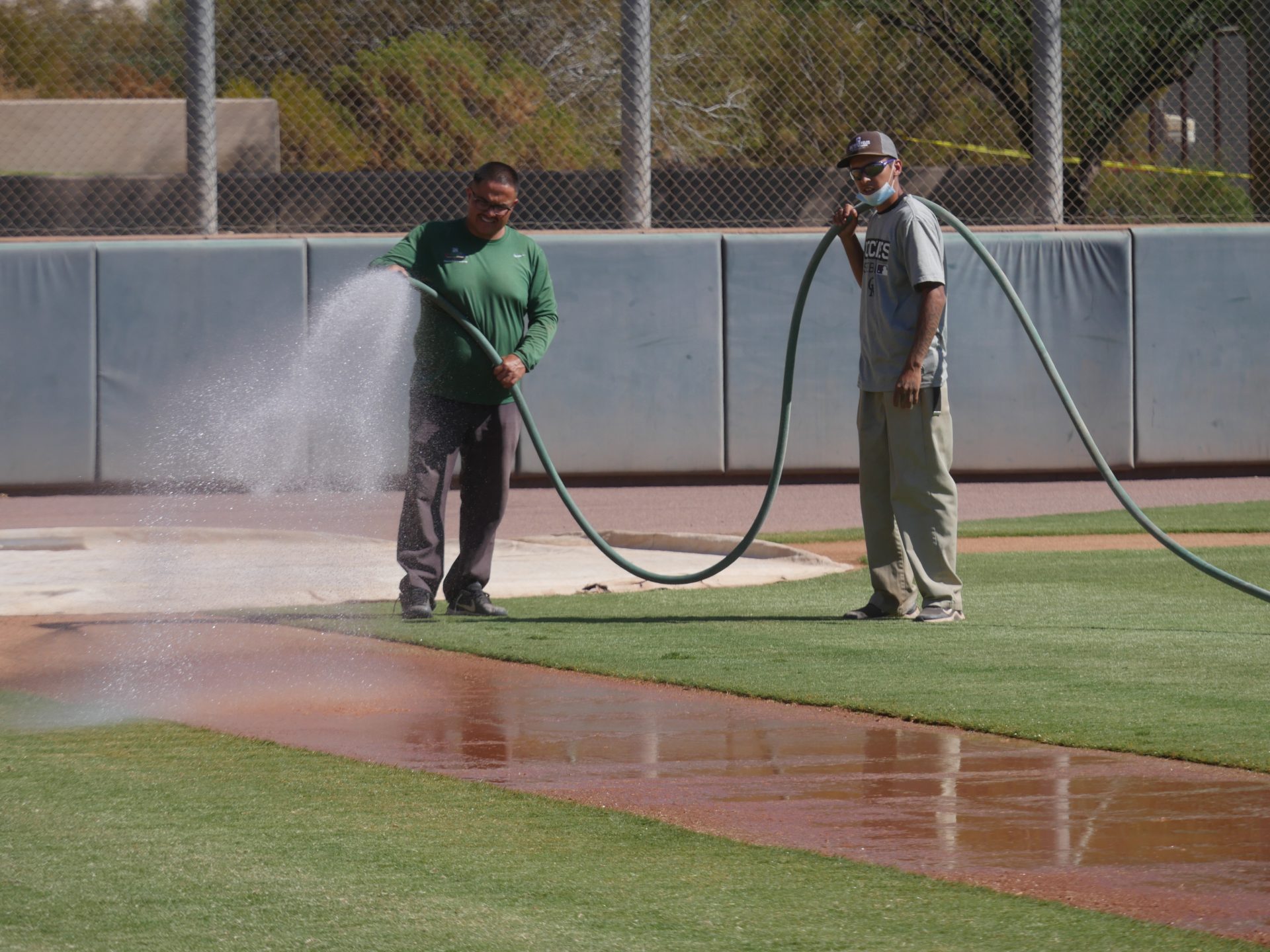VIEWS: 4867
November 4, 2020Salt River Fields Grounds Crew Maintains the Facility Year-Round
After spring training, when the Arizona Diamondbacks move a few steps over to Phoenix and the Colorado Rockies make their mile-high trek back home, the grounds crew at Salt River Fields at Talking Stick is just getting warmed up.
Marshall Jennings is the head groundskeeper at Salt River Fields. He has been at the stadium since July 2010, after previously spending eight years in Jupiter, Florida, as facility operations manager for the St. Louis Cardinals and Miami Marlins.
Under his guidance, the groundskeeping staff stay year-round, including four employees from the Salt River Pima-Maricopa Indian Community, to keep the first professional baseball complex on tribal land in top shape.

SRPMIC member and Maintenance I grounds crew Art Medina dragging the warning track.
Not only does the stadium require upkeep, but the entire 140-acre complex requires attention during the offseason. The complex includes 13 full-size Major League Baseball fields, two agility fields, four half-fields, three bunting fields, 12 acres of multipurpose fields, plus additional common-area space.
“We define the offseason as when there is no baseball activity on the fields, which is typically mid-November through January 1. During this time, all 13 baseball fields are closed to user groups,” said Jennings.
“This year, both the Diamondbacks and Rockies are hosting a Fall Instructional League/Fall Development Program from October 1 to November 7, which completes the baseball schedule and begins the ‘offseason.’”
Coming up in November, 120 baseball mounds will be rebuilt, and new pitching rubbers and home plates will be installed as needed. Infields will be roto-tilled and laser-graded as well, while warning tracks are graded and other projects will be completed prior to the Diamondbacks and Rockies returning to the facility for early workouts beginning in January.
Each field will also be overseeded with perennial ryegrass, which is the primary grass used during the winter and spring months.
According to Jennings, the field’s foundation is 419 bermudagrass, which is a warm-season grass that reaches maximum growth during the summer months. Growth begins to slow down in the fall and will go into winter dormancy as the nights get cooler and daylight hours become shorter. The bermudagrass will eventually turn brown after the first frost, which is not a desirable color for the winter and spring busy season.

The field is overseeded with the perennial ryegrass to combat this color loss. As the weather warms up in May and June, the cool-season ryegrass eventually dies off due to the excessive heat and the bermudagrass begins growing again. This is referred to as the “transition period” and it’s typically the most difficult time of year to grow grass.
Irrigation is a critical component for keeping the grass alive year-round. “With no measurable rainfall at Salt River Fields this summer, coupled with record heat, it was definitely more difficult than previous years,” said Jennings. “We have two irrigation technicians who constantly monitor the programming, run times and distribution uniformity of sprinkler heads. Their main role is to make sure the system is functioning efficiently so the grass is getting adequate water.”
All of the infields are constructed from a local material provided by Stabilizer Solutions called “stabilizer brown infield mix,” according to Jennings. The different materials on the warning track and the mounds and home plates are provided by Stabilizer Solutions, DuraEdge products and Turface Athletics.

In addition to overseeing grounds operations, Jennings also handles the sports rental contracts for amateur baseball and soccer groups. He says that there must be a balance between field usage and adequate downtime for maintenance and recovery of the grass. “Some facilities tend to overbook their fields without accounting for proper maintenance practices. Ultimately, the quality of the playing surface begins to decline and becomes substandard for professional-level play. We attempt to meet or exceed revenue goals while controlling expenses and not compromising the conditions of the fields.”
The COVID-19 pandemic has thrown a wrench into just about every facet of life, and Salt River Fields and sports in general were not immune to this. Major League Baseball decided to cancel this year’s Arizona Fall League, which affected the field maintenance schedules. The 2021 spring training schedule at Salt River Fields has been announced, and the first Diamondbacks home game vs. the Rockies is slated for Saturday, February 27, 2021. Head to https://saltriverfields.com/spring-training-at-salt-river-fields/ for more spring training information.







